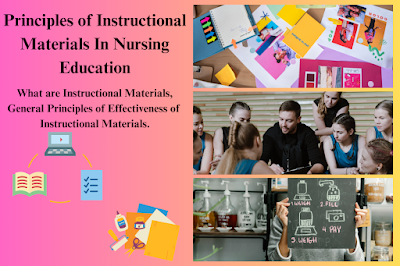What are Principles of Instructional Materials In Nursing Education. The principles discussed are appropriateness, authenticity, interest, organization, and balance.
The Principles of Instructional Materials In Nursing Education
In nursing education, effective teaching materials must be appropriate, authentic, engaging, and well-structured to support learning. They must also be student-centered and relevant, providing meaningful feedback to promote understanding and skill development. Teaching materials should be level-appropriate, provide accurate information, spark students’ interest and motivation, and have a clear purpose with a logical structure.
What are Instructional Materials?
Instructional materials are essential tools in nursing education that help communicate information to learners. While teaching methods are the approaches educators use to present and deliver information, instructional materials are the mediums through which that information is transmitted. These tools include printed materials, demonstration aids, audiovisual media, and other resources that complement teaching strategies. They help clarify and enhance the learning experience, making it easier for students or patients to grasp complex concepts or procedures.
Unlike teaching methods, which are focused on the approach to delivering content (e.g., lectures, group discussions), instructional materials provide tangible or visual means to reinforce learning. They should not replace the educator but act as supplementary resources that enrich the teaching-learning process. These materials cater to different learning styles and help simplify abstract concepts, making learning more efficient and effective.
Given the complexity of today’s healthcare system—such as increasing patient acuity, varied learning preferences, and alternative settings for care—nurse educators must carefully select the appropriate materials to support their teaching goals. Whether educating nursing students, patients, or fellow nurses, effective use of instructional materials can significantly impact knowledge retention, skill acquisition, and overall learning success.
General Principles of Effectiveness of Instructional Materials
When selecting or developing instructional materials for nursing education, educators should consider several key principles to ensure their effectiveness. These principles guide the selection of materials to maximize their benefit to the learner and achieve the desired educational outcomes.
- Familiarity with Content and Tools
Before using instructional materials, educators should be familiar with both the content and the mechanics of the tool. Understanding how to effectively use the material is essential for delivering clear and accurate information to learners. - Influence on Learning Domains
Instructional materials can influence cognitive (knowledge), affective (attitudes), and psychomotor (skills) development. Choosing the right materials can enhance learning across these domains, making them more effective at changing behavior and understanding. - Suitability Depends on Variables
No single instructional tool is universally superior. The suitability of instructional materials depends on various factors such as the topic, learners’ needs, and the context in which they are used. Educators should assess the appropriateness of a tool based on the specific teaching objectives. - Complement, Don’t Replace, Teaching
Instructional materials should supplement the educator’s efforts rather than substitute them. These tools reinforce and clarify the material being taught, helping learners engage with and retain information. However, they should never take the place of direct teaching by the educator. - Financial Resources Consideration
The choice of instructional materials should align with the financial resources available. Nurse educators must balance the quality and effectiveness of the materials with budget constraints. - Appropriate for Learning Environment
Instructional aids must fit the physical conditions of the learning environment, including space, lighting, sound projection, and the availability of hardware for audiovisual materials. Tools should be selected based on how well they integrate into the existing environment without technical or logistical difficulties. - Match Learners’ Abilities
Instructional materials should be tailored to the sensory abilities, developmental stages, and educational levels of the learners. For example, visual aids may be less effective for individuals with visual impairments, while complex medical terminology may not be suitable for patients with lower health literacy levels. - Accuracy and Relevance
The content presented through instructional materials must be accurate, up-to-date, and relevant to the learners’ needs. Educators should ensure that the information is unbiased, free of unintended content, and culturally sensitive. Inaccurate or outdated materials can lead to confusion or misinformation. - Meaningful Contribution
The instructional materials should contribute meaningfully to the learning experience by adding clarity, reinforcing key points, and simplifying complex topics. They should not be used solely for the sake of variety but should enhance the learning situation in a way that benefits the learner.
Conclusion
Instructional materials play a crucial role in nursing education by reinforcing and enhancing the effectiveness of teaching methods. These tools—whether printed handouts, demonstration models, or audiovisual aids—serve to clarify and simplify complex information, making learning more engaging and effective. By adhering to the general principles of effectiveness when selecting and using these materials, nurse educators can ensure that they align with learners’ needs, teaching objectives, and available resources, ultimately leading to more successful educational outcomes.
Read More:
https://nurseseducator.com/didactic-and-dialectic-teaching-rationale-for-team-based-learning/
https://nurseseducator.com/high-fidelity-simulation-use-in-nursing-education/
First NCLEX Exam Center In Pakistan From Lahore (Mall of Lahore) to the Global Nursing
Categories of Journals: W, X, Y and Z Category Journal In Nursing Education
AI in Healthcare Content Creation: A Double-Edged Sword and Scary
Social Links:
https://www.facebook.com/nurseseducator/
https://www.instagram.com/nurseseducator/
